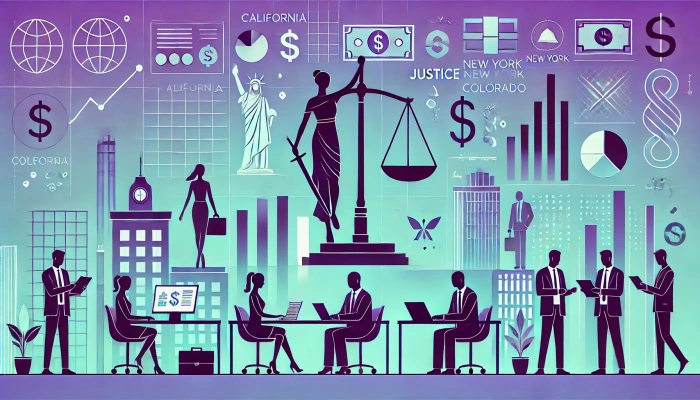
Pay Discrimination Examples: The Steep Price of Pay Inequity

In an era where diversity, equity, and inclusion are no longer just buzzwords but business imperatives, the specter of gender pay discrimination continues to haunt Corporate America. Recent years have seen a surge in high-profile lawsuits and settlements that have not only hit companies’ bottom lines but also dealt significant blows to their reputations.
Although the Civil Rights Act and federal laws provide protections against wage discrimination based on race, color, religion, sex, or national origin, employment discrimination is still rampant in the US. As the dust settles on these legal battles, it’s clear that the true cost of pay discrimination extends far beyond the courtroom.
The Push for Equal Pay Transparency
Before we dive into the corporate casualties, let’s set the stage. The fight for pay equity in the US has been gaining momentum, with several states enacting pay transparency laws. California, New York, and Colorado have been at the forefront, requiring employers to disclose salary ranges in job postings and provide pay scale information to current employees upon request. The Fair Pay Act in states like New York and California includes provisions for prohibiting pay discrimination based on sex, race, or ethnicity, and outlines legal actions individuals can take in case of pay disparities. These laws aim to shine a light on pay practices and empower workers to advocate for fair compensation.
But as we’ll see, even in states with robust laws, some of America’s most prominent companies have found themselves on the wrong side of pay equity.
The Corporate Hall of Shame
Google: The Search Giant's $118 Million Oversight
In October 2023, Google faced its first trial over alleged pay discrimination. The case centered around an executive named Ulku Rowe, who alleged she was hired at a lower level and salary than equally or less qualified men. A jury found Google guilty of sexual discrimination and awarded Rowe $1.1 million in damages.
This is not the first of Google’s sins against pay equity. The tech giant paid out settlements already twice.
First in 2017, when accused by the U.S. Department of Labor of systematic pay discrimination against women, they settled for $3.8 million in back pay.
And second, in June 2022, when the company agreed to pay a whopping $118 million to settle a class-action lawsuit alleging it underpaid female employees. The suit, covering about 15,500 women in 236 job titles, claimed Google paid women less than men for doing substantially similar work.
The irony wasn’t lost on many: a company that prides itself on data-driven decision-making had apparently failed to apply that same rigor to its compensation practices. The settlements required Google to allow third-party experts to analyze its hiring and pay practices, a move that signaled a shift towards greater transparency. The allegations against Google highlighted significant pay differences that raised questions about the legality of their pay practices.
Microsoft: A $238 Million Wake-Up Call
Microsoft’s reckoning came in 2018 when it agreed to pay $238 million to settle a gender discrimination lawsuit. The suit, filed in 2015, alleged that the tech giant’s “stack ranking” system systematically undervalued male and female employees in engineering and technical roles, violating the principles of the Equal Pay Act of 1963.
The settlement covered more than 8,000 female employees and required Microsoft to overhaul its performance evaluation and promotion practices. It was a stark reminder that even companies touting progressive values aren’t immune to systemic biases.
Uber: A $10 Million Ride to Equality
Ride-hailing giant Uber found itself in hot water in 2018, agreeing to pay $10 million to settle a class-action lawsuit alleging discrimination and unequal pay against women and people of color. The suit claimed Uber’s performance evaluation system unfairly disadvantaged these groups, leading to lower pay and fewer promotions.
As part of the settlement, Uber committed to reforming its compensation and promotion practices. The case highlighted how emerging tech companies, often praised for disrupting traditional industries, could still perpetuate old-school discrimination.
Nike: When Brand Image and Reality Collide
Nike faced its first lawsuit in December 2023, when Lauren Hubler, a senior finance director, sued for $6 million, alleging that as a female employee, she experienced pay discrimination. This case revives concerns about Nike’s workplace culture that first surfaced in 2018. The company experienced significant brand damage as the internal complaints about pay inequity and workplace culture became public. The revelations led to the departure of several top executives and forced Nike to overhaul its compensation practices.
The sportswear giant, known for empowering marketing campaigns featuring female athletes, found its carefully crafted image at odds with its internal reality. It was a stark reminder that in the age of social media, internal issues can quickly become public relations nightmares.
US Women's National Soccer Team: Pay inequity at non-profits
In a case that captured national attention, the US Women’s National Soccer Team filed a lawsuit against the US Soccer Federation in 2019, alleging gender-based pay discrimination for the same job. In 2022, they reached a landmark $24 million settlement, which included a commitment to equal pay for the men’s and women’s teams in all competitions.
This case transcended sports, becoming a rallying cry for pay equity across industries. It demonstrated the power of collective action and public pressure in driving change.
Apple: The $30 Million Bite
In June 2024, two female employees filed a proposed class action lawsuit against Apple, alleging gender-based pay discrimination, biases against women in its performance evaluation system, and maintenance of a hostile work environment. The complaint encompasses more than 12,000 current and former female employees in California.
This is not the first offence. Already back In 2021, Apple agreed to pay $29.9 million settlement brought by employees at its California retail stores. The employees alleged they weren’t paid for time spent undergoing security bag checks at the end of their shifts.
While not strictly a gender pay discrimination case, it highlighted the broader issue of fair compensation practices. The settlement came as Apple faced growing scrutiny over its treatment of retail workers and warehouse employees. Allegations included scenarios where a male employee was paid more than a female coworker, raising concerns about potential pay discrimination.
Activision Blizzard: A $54 Million Reckoning
And finally, even the long-criticized gaming industry hasn’t escaped the law as Activision Blizzard agreed to pay $54 million in December 2023 to settle a lawsuit filed by the California Civil Rights Department. The suit alleged the company fostered a culture of sexual harassment and gender-based discrimination, including wage discrimination and pay difference. This settlement, substantially larger than previously reported figures, underscores the growing financial risks companies face when failing to address workplace equity issues.
The case was particularly damaging for Activision Blizzard, coming amidst broader allegations of a toxic workplace culture. It served as a wake-up call for the gaming industry, long criticized for its treatment of women and minorities, and highlighted the increasing willingness of state and federal agencies like the Equal Employment Opportunity Commission to pursue substantial penalties for workplace discrimination.

Beyond the Bottom Line: The Hidden Costs of Pay Discrimination
While the financial costs of these settlements are eye-watering, the true toll on these companies extends far beyond their balance sheets.
Here are pay discrimination's hidden costs:
1. Reputational Damage:
In the age of social media and 24/7 news cycles, negative publicity spreads like wildfire. Companies embroiled in pay discrimination lawsuits often find themselves the subject of viral hashtags, scathing op-eds, and relentless media scrutiny. A good case in point is the spread of the #JustPayIt hashtag - a clever twist on Nike’s famous slogan “Just Do It.” This damage to brand reputation can linger long after the legal dust has settled, as the phrase continues to resurface whenever the company faces new scrutiny over its workplace practices.
2. Employee Morale and Productivity:
Nothing kills workplace morale faster than the perception of unfairness. When employees believe they’re being systematically undervalued, it can lead to decreased productivity, increased absenteeism, and higher turnover rates. The cost of replacing disgruntled employees and rebuilding team cohesion can far exceed the initial pay disparities.
Let’s take a look at Activision Blizzard’s case. Mass employee walkouts directly impacted productivity, and with morale at an all-time low, many employees reported difficulty focusing on their work. Some teams had to delay game releases or updates due to the upheaval.
3. Talent Acquisition and Retention:
Top talent has options in a competitive job market. Companies with a reputation for pay inequity may find it increasingly difficult to attract and retain skilled workers, particularly women and minorities. This can create a vicious cycle where the lack of diversity further perpetuates pay gaps.
That’s exactly what happened to Activision Blizzard. Potential hires withdrew their applications, and the controversy caused numerous high-profile employees to leave, leading to the loss of key talent.
4. Consumer Boycotts:
In an era of conscious consumerism, customers increasingly vote with their wallets. Companies perceived as unfair or discriminatory may face boycotts or lose market share to competitors seen as more equitable employers.
Nike is a case in point. Many consumers publicly pledged to stop buying Nike products until the company addressed its workplace issues. Some posted photos of themselves discarding or destroying the company’s products, which went viral on social media.
5. Investor Skepticism:
Pay equity issues can raise red flags for investors, who may view them as indicators of poor governance or mismanagement. This can lead to decreased investor confidence and potentially impact stock prices.
In 2019, Alphabet (Google’s parent company) faced a shareholder resolution demanding that the company report on its global median gender pay gap. This resolution, while not passed, received significant support, indicating growing investor concern about the issue.
Even Google’s stock took a noticeable dip in price, when the company faced a significant lawsuit over pay discrimination in 2017.
6. Regulatory Scrutiny:
High-profile lawsuits often attract the attention of regulators and lawmakers. Companies may find themselves subject to increased oversight, audits, or even new legislation addressing pay disparities.
Uber’s issues with gender discrimination and pay equity have led to significant regulatory scrutiny, including federal investigations, high-level actions from the California Department of Fair Employment and Housing, as well as industry-wide scrutiny prompting regulators to look more closely at pay practices in the gig economy and tech industry as a whole.

The Transparency Imperative: Federal Equal Pay Act
As these cases demonstrate, pay inequity costs extend far beyond legal settlements. In today’s hyper-connected world, attempts to sweep discrimination under the rug will likely backfire spectacularly.
Companies that prioritize transparency, even when it means acknowledging and addressing uncomfortable truths, are better positioned to weather the storm. Organizations can build trust with employees, customers, and investors by proactively auditing pay practices, publishing salary data, and committing to ongoing improvements.
Moreover, transparency can serve as a powerful catalyst for change. Bringing to light pay disparities creates accountability and motivation to address them. It also empowers employees to advocate for themselves and each other, fostering a culture of fairness and inclusion.
The Road Ahead
As we move forward, it’s clear that pay equity is no longer just a legal or HR issue – it’s a strategic business imperative. Pay discrimination based on gender, race, age, and other protected characteristics must be addressed to ensure fairness. Companies that fail to address these issues risk hefty financial penalties and long-lasting damage to their brands, employee relations, and market positions.
The message is clear: address pay equity proactively, or risk becoming the next cautionary tale in the ongoing fight for workplace fairness. In today’s business landscape, the cost of inaction is too high to ignore.
As consumers, employees, and investors increasingly demand fairness and transparency, companies have a choice to make. They can view pay equity as a burden to be managed or an opportunity to lead. Those who choose the latter – embracing transparency, committing to ongoing improvement, and fostering a culture of inclusion – won’t just avoid costly lawsuits. They’ll build stronger, more diverse workforces, enhance their reputations, and ultimately, drive better business results.
In the end, pay equity isn’t just about dollars and cents. It’s about creating workplaces where everyone has the opportunity to thrive, regardless of gender, race, or background. And in doing so, companies don’t just do right by their employees – they set themselves up for long-term success in an increasingly competitive and socially conscious marketplace.
The choice is clear. The question is: which side of history will your company be on?
